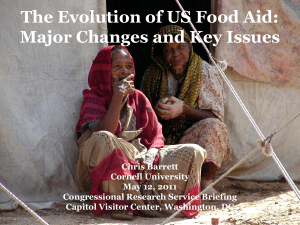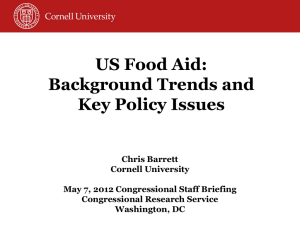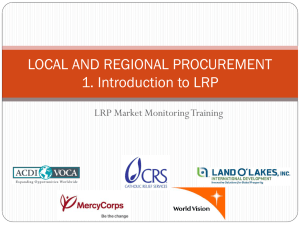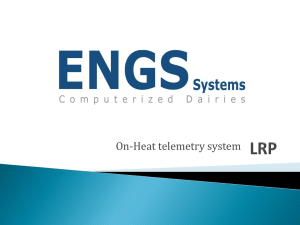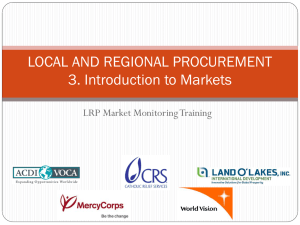Local and Regional Procurement of Food Aid
advertisement
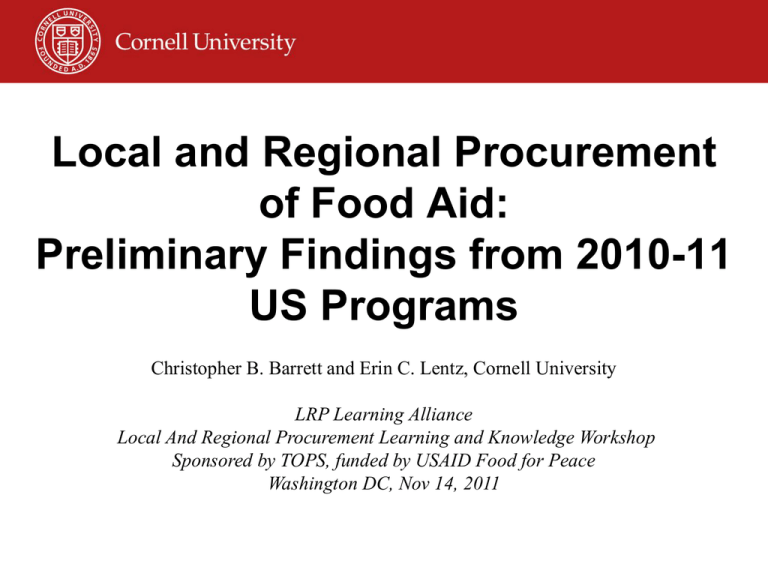
Local and Regional Procurement of Food Aid: Preliminary Findings from 2010-11 US Programs Christopher B. Barrett and Erin C. Lentz, Cornell University LRP Learning Alliance Local And Regional Procurement Learning and Knowledge Workshop Sponsored by TOPS, funded by USAID Food for Peace Washington DC, Nov 14, 2011 Introduction The LRP Learning Alliance A group of PVOs working together and with Cornell University to establish a common, rigorous framework for M&E of local and regional procurement (LRP) of food aid under the USDA LRP pilot program and the USAID Emergency Food Security Program. Materials on Learning Alliance web site at https://sites.google.com/site/lrplearningalliance/home. 2 The Global Framework Motivation for Global Framework Motivation for Framework Integrate reporting requirements of USDA and USAID Gather data needed to generate rigorous evaluation of LRP performance along multiple dimensions: timeliness, cost effectiveness, price/price volatility impacts, recipient satisfaction, smallholder supplier impacts Enable direct comparison across LRP project modalities and regions and with other forms of food aid (e.g., traditional transoceanic food aid) to inform policy deliberations Common database to manage data across projects Foster improved PVO market monitoring and analysis The Global Framework Data Collection and Analysis Tools Constructed eight forms to collect data systematically Data collected to analyze evaluation topics USDA required - Historic supply, demand and price movements; do no harm; reasonable market rate; timeliness; product quality and safety; cost; government interference Additional topics - Producer price stimulus; supplier behavioral change; volumes; and food production shocks Trained PVO personnel on price data collection methods and basic price analysis techniques. Materials available on Learning Alliance web site. Can help establish when/where/whether LRP makes sense 4 and what to monitor and key impacts on which to focus. Impacts: Preliminary Findings Preliminary Findings on LRP Impacts Evaluation Focus Areas • Timeliness • Costliness • Recipient Satisfaction • Impacts on Smallholder Suppliers • Impacts on Price Levels • Impacts on Price Volatility 5 Impacts: Preliminary Findings Preliminary Findings on LRP Impacts To date, we have sufficient data to do analyses on some dimensions for nine different programs: 1) Bangladesh (USDA LRPPP cereal bars from chickpeas, peanuts, puffed rice, sesame seeds, etc.) 2) Burkina Faso (USDA LRPPP cowpeas, millet, veg oil) 3) Guatemala (USDA LRPPP beans, CSB, white maize) 4) Kenya (USDA LRPPP maize, beans, CSB, vegetable oil, salt 5) Kyrgyzstan (USAID EFSP cash transfer) 6) Mali (USDA LRPPP cowpeas, millet, rice) 7) Niger (USDA LRPPP cowpeas, maize, millet and vouchers for salt and veg oil) 8) Uganda (USDA LRPPP vouchers) 9) Zambia (USDA LRPPP beans, CSB, maize, meal, veg oil) 6 Impacts: Preliminary Findings Timeliness of Deliveries Method Compare event histories of LRP and transoceanic (USAID or USDA) deliveries to the same country up to 6 months before or after an LRP purchase. Compare the time it takes from initiating procurement (IFB, tender release, etc.) until delivery to terminal warehouses for shipments from US vs. LRP. 7 Impacts: Preliminary Findings Timeliness of Deliveries (weeks) Burkina Faso (n=5/63) Zambia (n=6/2) Niger (n=10/12) Kyrgyzstan (n=1/7) Mean difference: 13.4 weeks (59%) Mali (n= 23/2) Kenya (n=23/25) Uganda (n=1/13) Guatemala (n=7/5) Bangladesh (n=24/9) 0 5 LRP 10 15 20 25 30 35 40 Transoceanic Huge, statistically significant gains in timeliness 8 Impacts: Preliminary Findings Delivered Commodity Cost Method Same comparison group as timeliness: LRP and transoceanic (USAID or USDA) deliveries to the same country up to 6 months before or after an LRP purchase. Now we match by commodity. Compare the cost of commodity, ocean freight and ITSH of LRP and transoceanic USAID or USDA shipments. 9 Impacts: Preliminary Findings Total Costs (Commodity + Ocean Freight + ITSH) Uganda Commodity (LRP / TO) Chickpea / Lentils Chickpea / Split Pea Veg Oil / Veg Oil Millet / Bulgur Cowpeas / Lentils Beans / Beans Incaparina / CSB Beans / Yellow Peas CSB / CSB Veg Oil / Veg Oil Cash* / Wheat Flour Cowpeas / Split Peas Millet / Bulgur Millet / Bulgur Millet / Sorghum Beans** / Yellow Peas LRP Transoceanic $601.81 $781.26 $601.81 $1,031.52 $2,065.01 $1,941.88 $334.83 $837.48 $566.07 $1,060.90 $1,085.20 $999.30 $1,919.03 $867.23 $711.94 $976.51 $800.01 $985.02 $1,689.00 $1,727.83 $470.04 $1,081.27 $543.45 $970.36 $300.59 $714.31 $399.02 $867.36 $399.02 $715.76 $662.95 $853.94 Zambia Maize flour**/ Cornmeal Beans / Beans $457.52 $1,148.00 Country Bangladesh Burkina Faso Guatemala Kenya Kyrgyzstan Mali Niger $934.26 $1,158.54 *Cash converted to wheat at prevailing market price in distribution zones **Vouchers converted to beans and maize at prevailing market price in distribution zones Total Savings 23% 42%** -6% 60%*** 47%*** -9% -121%*** 27%** 19%*** 2% 57%*** 44% 58% 54%*** 44% 22% 51%*** 1% 10 Impacts: Preliminary Findings Delivered Commodity Cost For processed products and beans, often little or no cost savings from LRP. Slight variations by region (e.g., veg oil in Kenya and Burkina, CSB in Kenya and Guatemala) But for cereals and some pulses very large (and stat. sig. savings). Pulses: Simple average savings = 34% over comparable commodities shipped from US to same (or neighboring) country during same half year. 11 Cereals: Simple average savings = 54% Impacts: Preliminary Findings Recipient Satisfaction In Burkina Faso, Guatemala and Zambia, in addition to the LRP program, there existed a nearby MYAP region delivering similar products during the same period. We ran household surveys to assess recipients’ satisfaction with food aid commodities received along various dimensions and costs of meal preparation. Rated preferences on specific attributes of the commodities they received on a scale of 1 (low) to 5 (high) Stated preparation needs from 1 (much more) to 5 (much less) Comparing LRP recipients vs. MYAP recipients gives us insights on preferences and perceptions of LRP recipients relative to those getting US-sourced commodities (i.e., MYAP). 12 Impacts: Preliminary Findings Recipient Satisfaction Estimated multivariate ordered logit models to control for potentially confounding factors. Results very similar to straight bivariate comparisons of LRP vs. MYAP. Core results: - Almost all food aid recipients satisfied with products on all dimensions. - But LRP recipients consistently most satisfied. This holds across countries and commodities. - But recipients’ preparation costs of LRP commodities often higher ... partly due to commodity differences? 13 Impacts: Preliminary Findings Recipient Satisfaction Sample multivariate ordered logit regression results Beans Guatemala Maize/Rice Incaparina/ CSB Burkina Faso Grain Legume (millet / (cowpeas / bulgur wheat) lentils) N/A N/A N/A N/A LEAP LEAP** LEAP LEAP*** LEAP* LEAP*** LEAP** LEAP*** MYAP** LEAP LEAP*** LEAP MYAP*** MYAP*** Quality LRP** LRP** LRP*** Quantity LRP MYAP LRP* Ration Size N/A N/A N/A Taste LRP*** LRP LRP** Texture LRP** LRP*** LRP* Appearance LRP** LRP*** LRP* Cleanliness N/A N/A N/A Storability LRP*** LRP*** LRP*** Nutritional LRP** MYAP* LRP content General LRP** LRP LRP LEAP Satisfaction ***, **, * Statistically significant at 1%,5% and 10% levels, respectively LEAP*** Zambia ZLRP/CFAARM rations Rations / Market (vs. market options) Options ZLRP** N/A N/A ZLRP** ZLRP*** ZLRP*** ZLRP* MYAP ZLRP** ZLRP** Note: Zambia method measures relative to equiv. commodity 14 available in local markets. Others use absolute measures. Impacts: Preliminary Findings Recipient Satisfaction Sample multivariate ordered logit regression results Guatemala Beans Time Effort Cost Fuel Use Water Use Cooking Oil Use LRP*** LRP** LRP LRP*** LRP*** MYAP Burkina Faso Maize/ Rice Incaparina /CSB LRP* LRP MYAP LRP MYAP N/A MYAP* LRP MYAP MYAP LRP N/A Grain (millet / bulgur wheat) MYAP*** MYAP*** MYAP* MYAP*** MYAP*** LEAP* Legume (cowpeas / lentils) MYAP*** MYAP*** MYAP MYAP*** MYAP MYAP Zambia ZLRP/CFAARM rations (vs. market options) MYAP* MYAP MYAP MYAP* MYAP*** ZLRP*** Note: Zambia method measures relative to equiv. commodity 15 available in local markets. Others use absolute measures. Impacts: Preliminary Findings Impacts on Smallholder Suppliers In Burkina Faso, used same matched MYAP/LRP zone technique to survey smallholder cowpea producers, comparing those supplying the LRP with otherwise identical ones in MYAP zone selling just into regular market system. Assess impacts relative to control group (LRP cowpea suppliers vs. cowpea farmers in MYAP region) Behavioral impacts – investments, improved storage, management practices (e.g. use of improved seed), use of credit Profitability impacts - self-reported improvements in profitability, farmgate price, transaction costs, time and distance travelled 16 Impacts: Preliminary Findings Impacts on Smallholder Suppliers Relative to previous year (intended and/or actual) participants: • had a better understanding of quality standards for cowpeas. • decreased travel time and distance traveled selling cowpeas by (stat. sig.) average margins of 52% and 91%, respectively. • received 49% higher cowpea prices and 41% higher revenue, on average. • enjoyed greater profitability in cowpea sales • no more likely to use improved farm management practices • direct LRP suppliers adopted improved storage practices (such as storing cowpeas in double- or triple-lined bags) due to their involvement in the program. 17 Impacts: Preliminary Findings Impacts on Food Price Levels Does LRP drive up food prices for farmers and/or consumers? Developed a statistical model to estimate the effect of LRP on food prices in local markets, controlling for a range of other factors that influence prices: inflation, climate (temp/precip) shocks, transport costs, seasonality, world market prices, WFP LRP activities in subject and neighboring countries, etc. Not strictly causal estimates due to potential for omitted relevant variables (e.g., government policies). But the best feasible means of estimate LRP’s effects on market prices. 18 Impacts: Preliminary Findings Impacts on Food Price Levels Estimated % Change Price Level Regression estimates of LRP’s market price impacts 15.0 10.0 Contemporaneous Price Impacts BFaso Kenya Guate Niger Kyrgyz Uganda Zambia 5.0 0.0 -5.0 -10.0 -13.90 -15.0 Beans -20.0 Roller Meal Mz flour B'fast Meal -13.51 -9.34 -16.04 Red indicates statistically significant coefficient estimates 19 Impacts: Preliminary Findings Impacts on Food Price Levels • For most commodities and countries, there is no economically or statistically significant impact on prices. • For the few statistically significant point estimates, the values are negative and implausibly large, suggesting unobserved parallel (gov’t?). • The possibility of significant induced price effects underscores the importance of market monitoring. • The relative infrequency of such effects suggests that LRP can be undertaken effectively when well designed and monitored. • Any price effects typically short lived; vanish within two months. 20 Impacts: Preliminary Findings Impacts on Food Price Volatility Does LRP increase food price volatility in recipient country markets? Used the same statistical model to estimate the effect of LRP on food price volatility, measured as the standard deviation of local market prices, controlling for same other factors. Again, not strictly causal estimates due to potential for omitted relevant variables (e.g., government policies). But pretty good. Result: Only 1/18 point estimates statistically significantly different from zero. 15/18 magnitude of point estimate 3% or less. No apparent effect of LRP on food price volatility. 21 Impacts: Preliminary Findings Summary of Preliminary Findings • Local purchase offers big gains in timeliness, at least 59% (13 weeks) quicker delivery than shipments from the US. • In cereals and pulses, there are considerable cost savings (~54% for cereals, 34% for pulses). Locally purchased processed products (e.g., CSB, vegetable oil), however, are often more expensive or near parity. • Recipients routinely prefer locally purchased commodities along any of multiple dimensions, although preparation time and costs of LP commonly greater. 22 Impacts: Preliminary Findings Summary of Preliminary Findings (2) • In Burkina Faso, smallholder suppliers enjoyed high prices and revenues and lower transactions costs. • For most commodities/countries, we find no economically or statistically significant impact on prices. But it can happen, which underscores the importance of market monitoring. • No market price volatility impacts of LRP. 23 Conclusions Overall, US PVOs’ LRP programs appear to substantially improve timeliness and reduce costs of food aid distribution, while generating increased recipient satisfaction with rations and some evidence of gains to smallholder suppliers, all without any consistent evidence of causing harm via significant price or price volatility effects. LRP not justified in all cases, but successful on most counts so good reason to push for it to become a broader option. Couple an expanded LRP option with response analysis to choose the right tool for the task and some sort of consortium M&E platform to reduce costs of high quality of M&E. 24 Thank you for your time, attention and comments! 25

